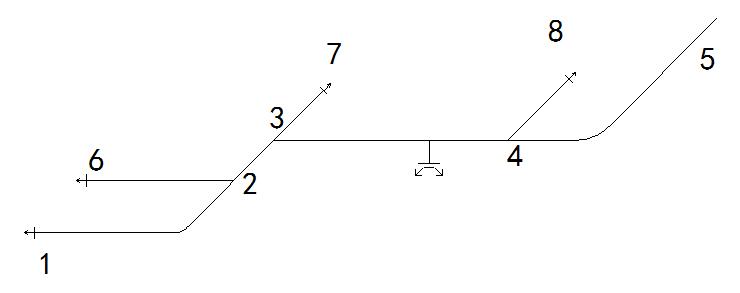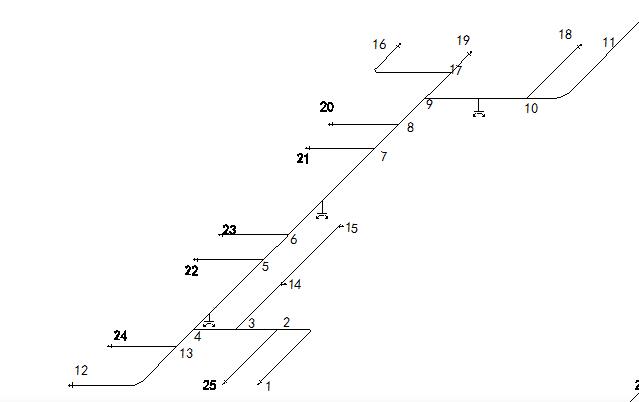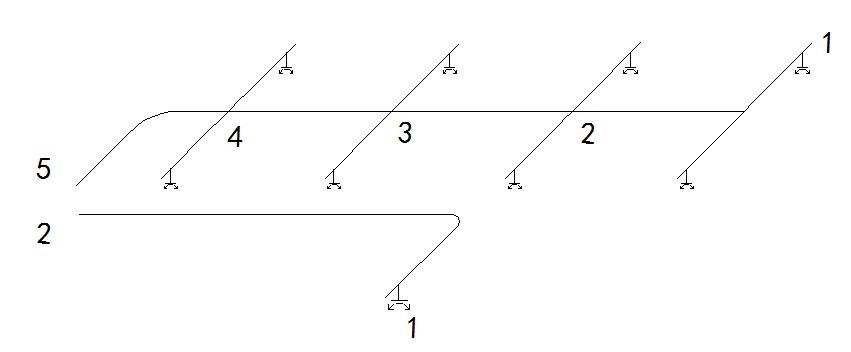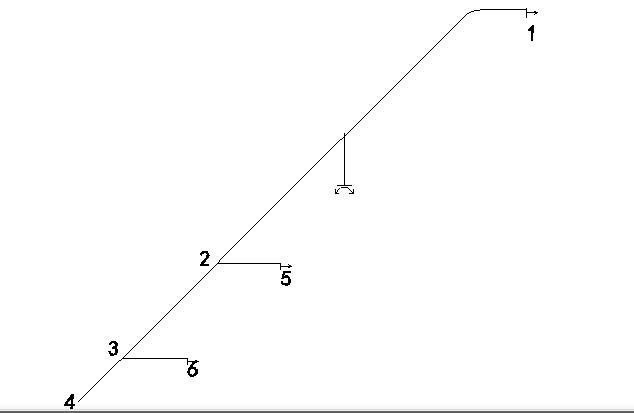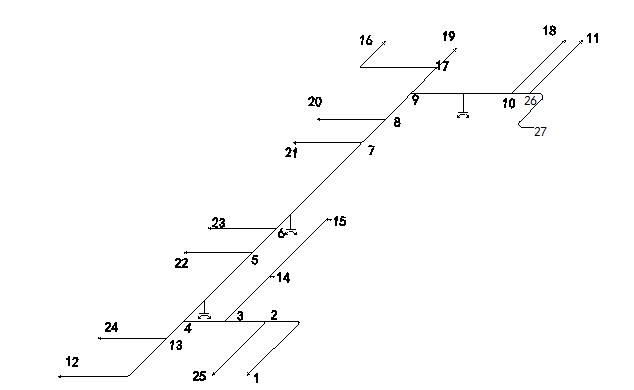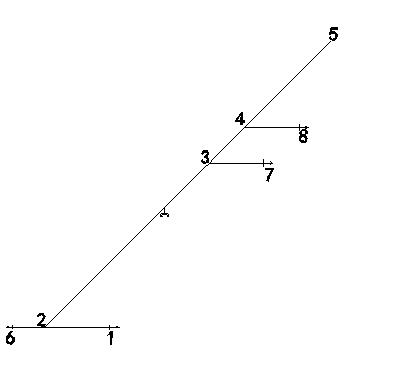南京钟山国际交流中心空调设计毕业论文
2020-06-19 22:24:32
摘 要
本工程位于江苏省南京市,为地下一层,地上三层的集活动室、会议、展示、客房等多功能的四层建筑,建筑层高:地下一层和地面一层4.2米,二层和三层3.6米,总高度为15.60米。建筑总面积为:6223.5平方米左右。地下一层房间分布有展示厅、老人活动室、厨房;一层有老人活动室,员工休息室及会议室、茶室;二楼为标间、大堂及会议室;三层为客房、咖啡厅及会议室等。
本设计在原平面图的基础上,根据相关设计规范要求,进行民用建筑空气调节系统设计。首先采用谐波反应法的工程简化方法计算出逐时冷负荷,采用面积指标法估算出热负荷。地下一层的展示大厅,一层的茶室,二层的大堂、咖啡厅采用全空气一次回风系统,其余房间采用风机盘管加独立新风系统。茶室和咖啡厅均采用方形散流器进行下送风,展示大厅和大堂采用电动旋流风口进行下送风,风机盘管加独立新风系统采用格栅风口进行侧送风。空调水系统采用一次泵定流量闭式系统。夏季采用一台螺杆式冷水机组进行供冷,冬季采用一台燃油热水锅炉进行供热。本设计充分考虑到了节能的要求,通过水力计算确保系统能够正常运行。本设计对设备的消声减震、管道保温也做了一定的讨论。工程图纸全部采用AutoCAD 2012进行绘制,使设计具有真实性和直观性。
关键词:空气调节 供冷 供热 节能
HVAC System Design of a Psychiatric Prison Building in Nanjing
Abstract
The building located in Nanjing City is a four-floor psychiatric prison building. The building floors consist of a layer of 3.9 meters, two to 3.6 layers of four meters, the total height of 14.70 meters. The total construction area is 5494.69 square meters. On the first layer are warehouse, monitoring room, office, rehabilitation work area, meeting rooms, etc. and on the second to fourth floors are the wards, activities room, monitoring room, therapeutic room, office, etc.
Based on the original plan, the design of the HVAC system of civil buildings is designed according to the requirements of the relevant design specifications. Firstly, the hourly cooling load is calculated by the method of harmonic response method, and the heat load is estimated by the method of the index method.The rehabilitation work area and the conference room adopt the primary return air system and the rest rooms adopt fan coil unit plus fresh air system. All air conditioning rooms are flat with a square diffuser.The air conditioning water system uses two times pump constant flow closed system. In the summer, two sets of centrifugal chiller are used for cooling, and two sets of hot water boiler are used for heating in winter. This design fully takes into account the energy saving requirements, through the hydraulic calculation to ensure that the system can operate normally. The design of the equipment noise reduction, pipe insulation also made a certain discussion. All engineering drawings are drawn by AutoCAD 2014, so that the design is true and intuitive.
Key Words: Air conditioning;Cooling;Heating; Energy conservation
摘要 I
Abstract II
第一章 工程概况与原始资料 6
1.1 工程概况 6
1.2 原始资料 6
1.2.1围护结构参数 6
1.2.2推荐照明功率 6
1.2.3推荐设备功率 7
1.2.4推荐空调使用时间 7
1.2.5人员密度 7
1.2.6南京市空调室外设计参数 7
1.2.7空调室内设计参数(夏季) 7
第二章 负荷计算 8
2.1 空调冷负荷、湿负荷计算 8
2.1.1用冷负荷温度计算围护结构传热形成的冷负荷 8
2.1.2用冷负荷系数计算窗户因日射得热形成的冷负荷 8
2.1.3 内围护结构传热形成的冷负荷 9
2.1.4 人体散热形成的冷负荷 9
2.1.5 室内照明散热形成的冷负荷 9
2.1.6 室内设备散热形成的冷负荷 10
2.2湿负荷计算 10
2.3 空调热负荷计算 15
第三章 空调系统方案的确定 16
3.1 冷热源机组的确定 16
3.1.1 冷热源方案分析 16
3.2 空调系统的划分 17
第四章 空调房间风量、冷量计算与设备选型 19
4.1 空调房间新风量确定 19
4.2 全空气一次回风系统风量、冷量计算 19
4.3 风机盘管加独立新风系统风量、冷量计算 20
4.4 机组选型 22
第五章 空调房间气流组织计算 24
5.1全空气系统气流组织计算 24
5.2 风机盘管气流组织计算 25
5.3 侧送气流组织计算 26
第六章 空调风系统设计计算 27
6.1 通风管道的材料与形式 27
6.2 风系统水力计算步骤 27
6.3 空调系统1~10风系统轴测图及水力计算 27
6.4风系统并联管路阻力不平衡率计算 32
6.5 卫生间和厨房排气管道设计 32
6.6 厨房排气管道设计 32
6.7 防排烟设计 32
第七章 空调水系统设计计算 35
7.1空调水系统形式的确定 35
7.1.1冷冻水系统的选择 35
7.1.2 冷却水系统的选择 36
7.2 冷冻水系统水力计算 36
7.2.1水系统水力计算步骤 37
7.2.2水系统轴测图 38
7.2.3水系统并联管路阻力不平衡率计算 42
7.3 冷凝水管的设计计算 42
第八章 冷源设备选型与设计 43
8.1 冷负荷资料 43
8.2 制冷方式的选择 43
制冷方式的选择 43
8.3 制冷剂的选择 43
8.4 制冷机组选型及校核计算 44
8.4.1机组型号选择 44
8.4.2校核计算 45
8.5 制冷机房的布置原则 45
第九章 热源设备选型与设计 46
9.1 热负荷资料 46
9.2 燃料种类及其特性 46
9.3原水水质 46
9.4 锅炉型号和台数的选择 47
9.5 锅炉房的工艺布置 47
第十章、燃油供应系统设计 50
10.1确定燃油供应系统方案 50
10.2输油管线的水力计算 51
10.2.1管径的计算 51
10.2.2管长的确定 52
10.3管道水力计算 53
10.3.1沿程损失 53
10.3.2局部损失 54
10.3.3总阻力损失 54
10.4贮油罐: 54
10.5日用油箱 54
10.6油泵选型 54
10.7油过滤器 54
第十一章 冷热源机房冷源设备选型与设计 56
11.1 水泵选型 56
11.1.1冷冻水泵选型 56
11.1.2冷却水泵选型 56
11.1.3补水水泵选型 57
11.2 分集水器选型 58
11.3膨胀水箱 59
11.4电子水处理仪 61
11.5水过滤器 61
11.6 冷却塔选型 62
11.6.1冷却塔的位置: 62
11.6.2冷却塔的作用 62
11.6.3冷却塔的工作过程 62
11.6.4冷却塔冷却水量和风量的计算: 62
11.7水泵进出管径的确定 63
11.7.1冷冻水循环系统管径的确定 63
11.7.2 冷却水循环系统管径的确定 64
11.7.3 冷却水补水系统管径的确定 64
第十二章 冷热源机房热源设备选型与设计 66
12.1 锅炉板式换热器选型 66
12.2水质处理方案的确定 67
12.3水处理软化设备的选择 67
12.3.1水质处理方案的确定 67
12.3.2选循环水泵 68
12.4原水除氧及除氧设备的选择 69
12.5锅炉排污量 70
12.6给水泵的选型和管径确定 70
12.6.1给水泵选型 70
12.6.2给水系统水力计算 71
第十三章、管道的保温、抗震及防腐 72
13.1管道的保温 72
13.2减震降噪设计 72
13.2.1设备的减震 72
13.2.2机房减震抗噪 73
13.3管道的防腐 74
参考文献 75
结束语 77
附表一 冷负荷计算表
附表二 湿负荷计算表
附表三 综合计算表
相关图片展示:
